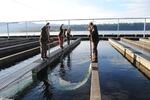
Hatchery workers use nets to guide young salmon out of the Spring Creek Fish Hatchery on the Columbia River in Underwood, Washington, on April 13, 2012.
Courtesy of the U.S. Fish and Wildlife Service
The National Oceanic and Atmospheric Administration released a final plan Tuesday for operating 62 hatchery programs in the Columbia River Basin while protecting threatened and endangered fish.
The plan calls for reducing hatchery production in some areas while increasing it in areas where hatchery fish don't pose a risk to threatened and endangered salmon and steelhead.
Hatchery fish can harm wild species by competing for food and spawning grounds when they stray from the hatcheries. Stray hatchery fish can also affect the genetics of wild fish through interbreeding.
“The science tells us that hatcheries can have benefits, but also present risks we have to consider,” said Rob Jones of NOAA Fisheries. “Every hatchery program offers it own unique set of benefits and risks, and we’re tailoring hatchery operations to maximize the benefits and minimize the risks.”
To reduce the impacts hatchery fish have on protected wild salmon and steelhead, the agency’s new plan calls for a halt to the use of hatchery broodstock from outside the Columbia River and reduced production in areas where research shows more hatchery fish have strayed.
For example, Jones said, the plan calls for reduced production at the Kalama and Big Creek hatcheries while increasing production at the Bonneville hatchery.
"We’ve looked at all the hatchery programs and we’ve looked at where their fish end up," he said. "Because we were able to do that, we were able to say this hatchery program is more responsible for strays than that hatchery program."
Overall, the new plan would reduce hatchery releases of chinook salmon and increase coho production, which will ultimately affect the allowable catch for sport, commercial and tribal fishermen in the Northwest.
Annual releases of hatchery fall chinook would drop from about 18 million to 14 million while releases of hatchery coho salmon would increase by about 4 percent.
NOAA’s new plan will determine how federal funds distributed through the Mitchell Act are used for hatcheries. In the past, Northwest hatcheries have received between $12 million and $22 million in Mitchell Act funds, which support more than 40 percent of the annual salmon and steelhead catch in the Columbia River. The 62 hatcheries in the Columbia River Basin produce more than 63 million fish.
The agency is facing new pressure to amend hatchery operations.
Last year, an environmental group called the Wild Fish Conservancy sued the agency to block the use of Mitchell Act funds at 10 hatcheries in the Columbia River Basin. The group argues NOAA is violating the Endangered Species Act by using the money to produce hatchery fish that threaten protected salmon and steelhead.
